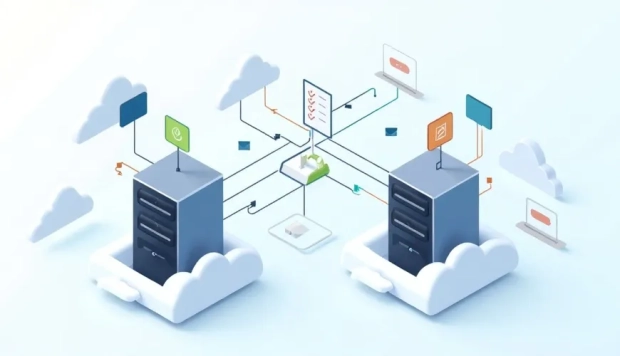The Evolution of Server Architecture in the Past Decade

The emergence of server structure follows the graph of increasing demands for expedition, ease of use, and robust security in contemporary digital systems. The pace of the world requires speed to market, while businesses require resilient infrastructure that does not sacrifice performance and safety. Servers, which many overlook, have silently underpinned this digital ascent from the shadows for over a decade.
In the past, they were big, complicated machines that took up entire rooms and demanded ceaseless hands-on management. Now, they're compact, efficient, and far more powerful, reflecting massive shifts in technology and design. This blog revisits how server architecture has transformed in recent years, and how these changes are laying the groundwork for the next era of IT infrastructure.
How have servers evolved over the years?
Servers have developed radically, from having room-size mainframes to compact yet strong units that can be placed in a regular server rack. The journey started with huge machines that demanded such facilities, massive cooling, and absurd amounts of electricity that their processing capacity seems quite limited by today's standards.
The 1970s saw the first advances with the arrival of microprocessors. These were chips that reduced the server size and power consumption, but radically enhanced computing performance.
In the 1990s, rack-mounted servers entered the market, providing better scalability and density. The traditional racks formed the foundation for the modern data centers and simplified the deployment and operations significantly. That was followed by the virtualization revolution in the early 2000s.
The VPS server USA can execute multiple operating systems on the same physical server, and as a result, the resources are better managed and the hardware cost is lower. And, in the end, that concept not only reinvented server management but also laid the foundation for the cloud, which is such a critical part of the modern IT world.
How have paradigms shifted in server architecture?
The past decade reveals distinct eras in server architecture, defined by predominant technology and business trends. The timeline table below encapsulates these significant changes:
Era | Timeframe | Core Characteristics | Technologies | Impact on Business |
|---|---|---|---|---|
Traditional | 2010 – 2013 | Physical servers are deployed on-premises, facilitating centralized management for manual provisioning. | Tower/rack servers, basic RAID, LAMP stack |
|
Virtualization | 2014 – 2016 | Virtual Servers abstract physical hardware, allowing multiple workloads to run on consolidated servers. | VMware, Hyper-V, XenServer, SAN storage |
|
Cloud | 2017 – 2019 | Enterprises shift to public and private cloud models with elastic compute, storage, and pay-as-you-go use. | AWS, Microsoft Azure, Google Cloud, OpenStack |
|
Container | 2020 – Present | Portable containers with orchestration are made possible by microservices architecture, allowing for quicker, modular deployments. | Jenkins, CI/CD pipelines, Docker, and Kubernetes |
Cost-effective resource use
|
Edge & AI | 2025 and beyond | Compute moves closer to endpoints with intelligent servers designed for real-time analytics and decisions. | Edge nodes, GPU-based servers, and AI chipsets |
|
Why are modern server solutions important for businesses?
Modern servers provide measurable business value by increasing resilience, performance, and cost-efficiency. They replace waste with optimized, refurbished servers, for instance, which can yield 4 x the ROI of traditional on-prem systems.
Cloud based VPS server solutions offer even greater returns, often generating four times the ROI of traditional on-premise setups. Beyond cost, today's servers allow businesses to scale quickly and perform reliably under pressure. From global apps to data-heavy platforms, modern infrastructure has transformed what's possible for companies of all sizes.
Principal Benefits of Modern Servers
-
Cost Efficiency: Refreshed servers can cost as much as 80% less than new ones. This avoids over-provisioning and cuts out unnecessary costs, while maintaining the performance during peak times.
-
High Performance & Scalability: Global platforms like Netflix deploy thousands of servers in minutes to meet massive demand spikes instantly. This shows that capacity can be added in hours instead of months.
-
Reliability & Fast Recovery: Cloud-first firms recover from major outages in ~2.1 hours vs. 8 hours for traditional setups. This incorporates high availability and automated backups to reduce downtime risk.
Tomorrow's Possibilities: Anticipating the Future of Server Architecture
The decade ahead promises dramatic shifts. Edge computing will continue to expand. As devices become connected, more of the data will be processed at the edge of the network. This can save both space and time by minimizing latency and the amount of bandwidth used. AI will inevitably be used in the next generation of servers, doing things like automatically allocating resources.
With this, Hyper-converged infrastructure (HCI) is a new trend. HCI bundles compute, storage, and networking into unified clusters. Analysts note that HCI handles edge data well. A small HCI cluster can cost less to build than replicating an equivalent traditional server setup.
Looking further out, quantum computing may reshape servers. Highly experimental still, quantum servers could theoretically tackle complex problems that are simply beyond the reach of even next-generation ordinary hardware. These innovations power the next wave of data centers and result in systems that are faster, more intelligent, and more responsive.
Why Choose Servers from Reliable Service Provider?
Modernization in server architecture in the past 10 years has revolutionized the way enterprises plan and manage their infrastructure. A transition from monolithic to distributed, cloud VPS Server systems has allowed organizations to reach a new scale in terms of efficiency, scalability, and reliability.
Reliable service provides server solutions in tune with today's demands and tomorrow's opportunities. Modelled for innovation and reliability, servers offer superior performance and sustainability for a variety of uses. This not only reduces operational costs but also helps corporations achieve their corporate responsibility targets.



